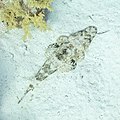Tentacled flathead
| Tentacled flathead | |
|---|---|

| |
| Scientific classification | |
| Domain: | Eukaryota |
| Kingdom: | Animalia |
| Phylum: | Chordata |
| Class: | Actinopterygii |
| Order: | Scorpaeniformes |
| Family: | Platycephalidae |
| Genus: | Papilloculiceps Fowler & Steinitz, 1956 |
| Species: | P. longiceps
|
| Binomial name | |
| Papilloculiceps longiceps (G. Cuvier, 1829)
| |
| Synonyms[2] | |
The tentacled flathead (Papilloculiceps longiceps), also known as the Indian Ocean crocodilefish, Madagascar flathead or longhead flathead, is a
Taxonomy
The tentacled flathead was first formally
Etymology
The genus name Papilloculicepsis a combination of papilla, meaning "nipple", and oculus, which means "eye", a reference to the small and inconspicuous flattened papilla on the upper surface of the eyeball this species with ceps, which means "head" suffixed The specific name means "long head" and may refer to the head of this fish being similar to that of a crocodile's.[6]
Description
The tentacled flathead has an elongate body with a depressed head with 5 prominent nuchal spines. The ridges on the preoperculum and
Distribution and habitat
The tentacled flathead is found in the western Indian Ocean from northern KwaZulu-Natal and Madagascar to the northern Red Sea.[1] A single record was reported in the Mediterranean Sea off Israel in 1986.[8][7] This species occurs near coral reefs on sand or rubble substrates at depths between 1 and 15 m (3 ft 3 in and 49 ft 3 in).[2]
Biology
The tentacled flathead is a well camouflaged, ambush predator of fish and crustaceans.[9]
Gallery
-
Crocodile fish at 20mRas Muhammad, Red Sea
-
Papilloculiceps longiceps andCymbacephalus beauforti are the two species of the family Platycephalidae which resemble crocodilesmost
-
Detail oflappetsover eyes
-
True colouration
References
- ^ . Retrieved 12 July 2022.
- ^ a b c Froese, Rainer; Pauly, Daniel (eds.) (2022). "Papilloculiceps longiceps" in FishBase. February 2022 version.
- ^ a b Eschmeyer, William N.; Fricke, Ron & van der Laan, Richard (eds.). "Species in the genus Papilloculiceps". Catalog of Fishes. California Academy of Sciences. Retrieved 12 July 2022.
- ^ Eschmeyer, William N.; Fricke, Ron & van der Laan, Richard (eds.). "Genera in the family Platycephalidae". Catalog of Fishes. California Academy of Sciences. Retrieved 12 July 2022.
- ISBN 978-1-118-34233-6.
- ^ Christopher Scharpf & Kenneth J. Lazara, eds. (7 December 2021). "Order Perciformes (Part 11): Suborder Platycephaloidei: Families Bembridae, Parabembridae, Hoplichthyidae, Platycephalidae and Plectrogeniidae". The ETYFish Project Fish Name Etymology Database. Christopher Scharpf and Kenneth J. Lazara. Retrieved 12 July 2022.
- ^ a b Daniel Golani & Adam Ben-Tuvia (1990). "Two Red Sea Flatheads (Platycephalidae) Immigrants in the Mediterranean". Cybium. 14 (1): 57–61.
- ^ Atlas of Exotic Fishes in the Mediterranean Sea (Papilloculiceps longiceps). 2nd Edition. 2021. 366p. CIESM Publishers, Paris, Monaco.https://ciesm.org/atlas/fishes_2nd_edition/Papilloculiceps_longiceps.pdf
- ^ "Papilloculiceps longiceps". Summit Post. Retrieved 13 July 2022.
- Froese, Rainer; Pauly, Daniel (eds.) (2007). "Papilloculiceps longiceps" in FishBase. 4 2007 version.
External links
- Photos of Tentacled flathead on Sealife Collection





